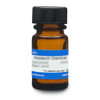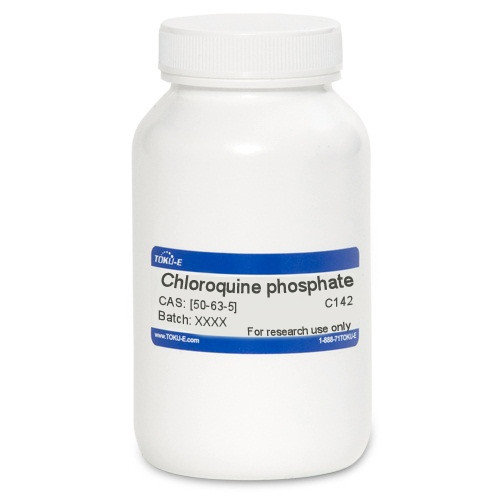Oseltamivir Phosphate is an inhibitor of influenza viral neuraminidase. It is also an antiviral used against influenza A and B. Oseltamivir was discovered at Gilead in 1997 using shikimic acid as a starting point for synthesis. The compound has promising anti-cancer activity. Oseltamivir Phosphate is slightly soluble in DMSO but sparingly soluble in water.
| Mechanism of Action | Oseltamivir Phosphate is converted to its active form (Oseltamivir Carboxylate) in vivo by hepatic esterases via ester hydrolysis. Oseltamivir Carboxylate inhibits influenza viral neuraminidase (syn: sialidase) , an enzyme which cleaves sialic acid residues. The residues are found on glycoproteins on the cell surface of human cells that help new virions exit the cell. The result is that the newly replicated virus cannot be released from infected cells of the respiratory tract and thus cannot replicate. |
| Spectrum | Oseltamivir has broad-spectrum activity against a range of influenza A and B subtypes, due to the conserved nature of the neuraminidase enzyme, which is highly selective for influenza only (neuraminidase A and B). It is effective for human seasonal viruses, avian viruses, and pandemic viruses including H1N1 virus. |
| Eukaryotic Cell Culture Applications | In a functional assay with MDCK cells, Oseltamivir Phosphate was assessed for antiinfluenza activity against influenza A virus H3N2 infected MDCK cells. Inhibition of virus-induced cytopathic effect was recorded after 36 hours; IC50=1.1 µM. |
| Microbiology Applications | Oseltamivir Phosphate IC50 range for influenza A and B subtypes is ≤ 1 nM - 30 nM. Resistance to Oseltamivir is due to single amino acid residue substitutions (His274Tyr in N1) in the neuraminidase enzyme. |
| Cancer Applications | The antitumor activity of Oseltamivir Phosphate was studied in a mouse model with human triple-negative breast adenocarcinoma using MCF-7 and MDA-MB-231 cell lines. The compound was able to completely ablate tumor vascularization, tumor growth, and metastasis when used at 50 mg/kg (Haxho et al, 2014).
The anti-cancer properties of Oseltamivir Phosphate was studied in human pancreatic cancer (PANC1) cells with acquired resistance to cisplatin and gemcitabine. Authors found it was efficacious in overcoming the intrinsic resistance of the cell to chemotherapeutics and metastasis. Targeting the Neu 1 sialidase enzyme with Oseltamivir Phosphate at the growth factor receptor level disables the signaling platform for cancer cells. It was able to reverse epithelial-mesenchymal transition (EMT), as demonstrated by the expression of N-cadherin, VE-cadherin and E-cadherin as characteristic markers of EMT, which is the suggested mechanism by which cancer cells acquire resistance to chemotherapy (O’Shea et al, 2014). |
| Molecular Formula | C16H28N2O4 ∙ H3PO4 |
| Solubility | Slighly soluble in DMSO. Sparingly soluble in water. |
| References |
Davies BE (2010) Pharmacokinetics of Oseltamivir: An oral antiviral for the treatment and prophylaxis of influenza in diverse populations. J. Antimicrob. Chemother. 65(S2):ii5-iii10 PMID 20215135 Govorkova EA et al (2009) Susceptibility of highly pathogenic H5N1 influenza viruses to the neuraminidase ihibitor Oseltamivir differs in vitro and in a mouse model. Antimicrob. Agents Chemother. 53 (7) 3088-3096 Haxho F et al (2014) Oseltamivir phosphate monotherapy ablates tumor neovascularization, growth, and metastatis in mouse model of human triple-negative breast adenocarcinoma. Breast Cancer 6:191-203 PMID 25525387 Kamal MA(2015) A drug-disease model describing the effect of Oseltamivir neuraminidase inhibition on influenza virus progression. Antimicrob. Agents Chemother. 59(9):5388-5395. PMID 26100715 Kim et al (1997) Influenza neuraminidase inhibitors possessing a novel hydrophobic interaction in the enzyme active site: Design, synthesis, and structural analysis of carbocyclic sialic acid analogues with potent anti-influenza activity. J. Am. Chem. Soc. 119(4):681-690 PMID 16526129 Leneva IA, Roberts N, Govorkova EA, Goloubeva OG, Webster RG (2000) The neuraminidase inhibitor GS4104 (Oseltamivir Phosphate) is efficacious against A/Hong Kong/156/97 (H5N1) and A/Hong Kong/1074/99 (H9N2) influenza viruses. Antiviral Res. 48(2):101-115 PMID 11114412 Li W et al (1998) Identification of GS 4101 as an orally bioavailable prodrug of the influenza virus neuraminidase inhibitor GS 4071. Antimicrob. Agents Chemother. 42(3):647-653 Oliyai R et al (1998) Biexponential decomposition of a neuraminidase inhibitor prodrug (GS-4104) in aqueous solution. Pharm. Res. 15(8):1300-1304 PMID 9706065 O'Shea LK et al (2014) Therapeutic targeting of Neu1 sialidase with Oseltamivir Phosphate (Tamiflu®) disables cancer cell survival in human pancreatic cancer with acquired chemoresistance. Onco. Targets Ther. 7:117-134 PMID 24470763 Sidwell RW et al (1998) Inhibition of influenza virus infections in mice by GS4104, an orally effective influenza virus neuraminidase inhibitor. Antiviral Res. 37(2):107-120 PMID 9588843 Vajaria B et al (2016) Sialylation: An avenue to target cancer cells. Pathol. And Oncol. Res. 22(2):443-447 PMID 26685886 |







